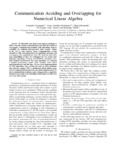Communication avoiding and overlapping for numerical linear algebra

Ver/Abrir
Use este enlace para citar
http://hdl.handle.net/2183/23395Colecciones
Metadatos
Mostrar el registro completo del ítemTítulo
Communication avoiding and overlapping for numerical linear algebraAutor(es)
Fecha
2013-02-25Cita bibliográfica
E. Georganas, J. Gonzalez-Dominguez, E. Solomonik, Y. Zheng, J. Tourino and K. Yelick, "Communication avoiding and overlapping for numerical linear algebra," SC '12: Proceedings of the International Conference on High Performance Computing, Networking, Storage and Analysis, Salt Lake City, UT, 2012, pp. 1-11.
Resumen
[Abstract] To efficiently scale dense linear algebra problems to future exascale systems, communication cost must be avoided or overlapped. Communication-avoiding 2.5D algorithms improve scalability by reducing inter-processor data transfer volume at the cost of extra memory usage. Communication overlap attempts to hide messaging latency by pipelining messages and overlapping with computational work. We study the interaction and compatibility of these two techniques for two matrix multiplication algorithms (Cannon and SUMMA), triangular solve, and Cholesky factorization. For each algorithm, we construct a detailed performance model that considers both critical path dependencies and idle time. We give novel implementations of 2.5D algorithms with overlap for each of these problems. Our software employs UPC, a partitioned global address space (PGAS) language that provides fast one-sided communication. We show communication avoidance and overlap provide a cumulative benefit as core counts scale, including results using over 24K cores of a Cray XE6 system.
Palabras clave
Program processors
Bandwidth
Partitioning algorithms
Linear algebra
Message systems
Hardware
Layout
Bandwidth
Partitioning algorithms
Linear algebra
Message systems
Hardware
Layout
Descripción
This is a post-peer-review, pre-copyedit version. The final authenticated version is available online at: http://dx.doi.org/10.1109/SC.2012.32





